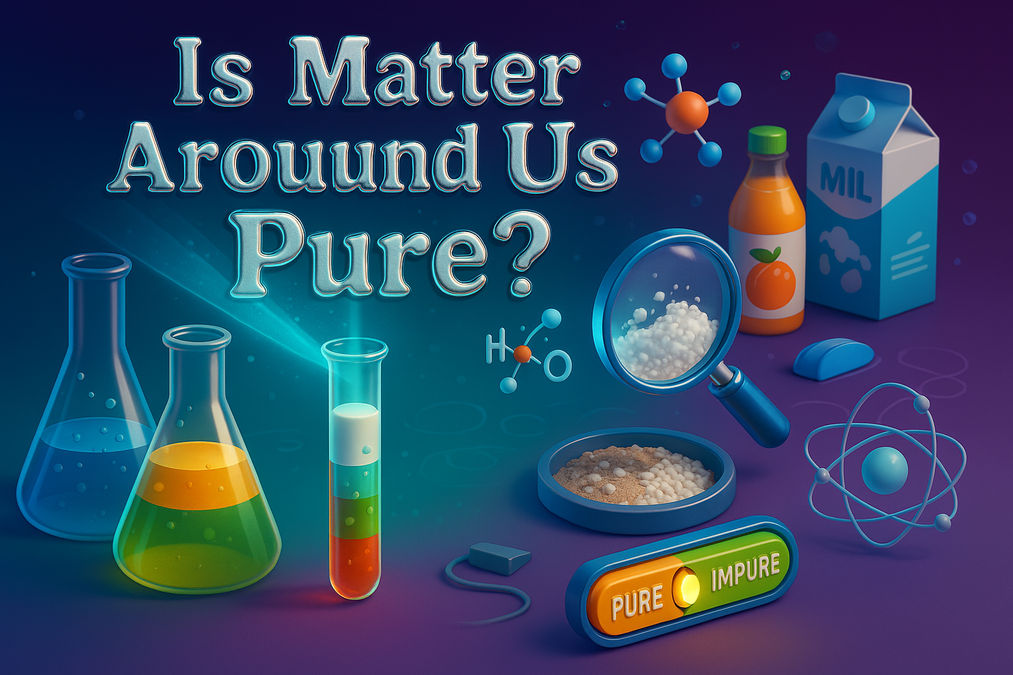Is Matter Around Us Pure? | Types of Mixtures, Solutions & Pure Substances

Is Matter Around Us Pure? Understanding Mixtures, Solutions, and Pure Substances
🌍 Introduction
Have you ever wondered if the milk, salt, or juice you consume is truly pure? For a common person, pure means free from adulteration, but scientifically, most substances around us are mixtures of different components. This blog explores the concept of purity in matter, types of mixtures, solutions, and the difference between elements and compounds.
🧪 What is a Pure Substance?
A pure substance consists of only one type of particle with uniform chemical properties. Examples include:
- Elements (Gold, Oxygen, Iron)
- Compounds (Water, Salt, Sugar)
However, most substances we encounter daily are mixtures—combinations of two or more pure substances.
🔬 Types of Mixtures
1️⃣ Homogeneous Mixtures (Solutions)
- Uniform composition throughout.
- Particles are too small to scatter light (no Tyndall effect).
- Examples: Saltwater, Sugar solution, Air.
2️⃣ Heterogeneous Mixtures
- Non-uniform composition.
- Particles are visible and may settle down.
- Examples: Sand in water, Oil in water.
⚗️ What is a Solution?
A solution is a homogeneous mixture with two components:
- Solvent (major component, e.g., water).
- Solute (minor component, e.g., salt).
Properties of a Solution:
- ✔ Particles are smaller than 1 nm.
- ✔ Does not scatter light.
- ✔ Stable (does not settle).
Types of Solutions:
| Solute State | Solvent State | Example |
|---|---|---|
| Solid | Liquid | Saltwater |
| Gas | Liquid | Soda water |
| Liquid | Liquid | Alcohol in water |
| Gas | Gas | Air (O₂ in N₂) |
🌡️ Concentration of a Solution
The amount of solute dissolved in a solution determines its concentration.
- Saturated Solution: Contains maximum solute at a given temperature.
- Unsaturated Solution: Can dissolve more solute.
Example Calculation:
If 40g salt is dissolved in 320g water:
\[ \text{Mass Percentage} = \frac{40}{360} \times 100 = 11.1\% \]
🌀 Suspensions & Colloids
🔹 Suspension
- Heterogeneous mixture with large particles.
- Scatters light (Tyndall effect).
- Particles settle down (e.g., Muddy water).
🔹 Colloidal Solution
- Particles are small but scatter light.
- Stable (does not settle).
- Examples: Milk, Fog, Shaving cream.
Tyndall Effect:
- Seen in colloids (e.g., sunlight through mist).
⚡ Physical vs. Chemical Changes
| Physical Change | Chemical Change |
|---|---|
| No new substance formed | New substance formed |
| Reversible | Irreversible |
| Example: Melting ice | Example: Burning paper |
🧲 Elements vs. Compounds
| Elements | Compounds |
|---|---|
| Cannot be broken down | Can be broken into elements |
| Single type of atom | Two or more elements combined |
| Example: Iron (Fe) | Example: Water (H₂O) |
🔍 How to Test Purity?
To check if a liquid is pure water:
- ✔ Measure boiling point (100°C at 1 atm).
- ✔ Check freezing point (0°C).
- ✔ Test for impurities using evaporation.
📝 Conclusion
Most matter around us exists as mixtures, while pure substances like elements and compounds have fixed compositions. Understanding solutions, suspensions, and colloids helps us distinguish between different forms of matter.
🔔 Call-to-Action:
Want to test solubility at home? Try dissolving salt, sugar, and baking soda in water at different temperatures!
❓ FAQs
1. What is a pure substance?
A substance with uniform chemical composition (elements or compounds).
2. What is the Tyndall effect?
Scattering of light by colloidal particles (e.g., milk in water).
3. How is a compound different from a mixture?
Compounds have fixed composition, while mixtures can vary.
4. What are examples of colloids?
Milk, fog, jelly, and shaving cream.
5. Can we separate mixtures easily?
Yes, using filtration, evaporation, or centrifugation.
Join the conversation